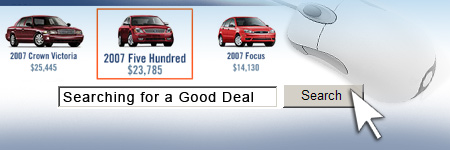
Online Car Shopping: Tips for Using the Web
Car shopping has never been easier for those who believe the perfect antidote to the dread of haggling face-to-face at the dealership is car shopping on the Web. Here, we simplify the process even more with tips that can help consumers zero in on the right model, take the car for a test drive, find the best price, and close the deal — all in the comfort of your own home.
Brought to you by the team at Consumer Reports’ Auto Test Center, who often uses the Internet, e-mail and telephone when anonymously buying test vehicles, the advice highlights the most important actions one can take when purchasing a car on the Web.
Here are the five steps recommended to find the right model, search dealers’ inventories, and nail the best price:
-
Zero in on the model — Find a suitable model for your taste and budget by reading new car reviews and reviewing reliability and safety data. You can also print out details on the models and options you’ve chosen at the carmakers’ own Web site.
-
Take a test spin — The Internet is no substitute for a test drive. Do your best to focus on the car and its handling and not be distracted by the salesperson’s small talk. While you’re at the dealership don’t try to negotiate a price; instead get an email address and a phone number so that you can do so later.
-
Go price shopping — Many carmaker’s Web sites let you configure the vehicle the way you want it, then forward the results to the dealers, who can get back to you with offers. Many sites, such as GM’s and Nissan’s, also let you search dealer inventory. It’s often faster to contact dealers directly, by phone.
Be as specific as possible about the model and options you have in mind. Stress that you’re ready to buy and want the dealers to give you their best price, including a complete list of any additional fees. To put those offers in perspective, it helps to know how much wiggle room the dealer has to haggle. You can find out what the dealer paid for the car as well as any rebates and factory –to- dealer incentives, at car-pricing websites.
-
Drive a better bargain — If you aren’t satisfied with the prices you’re offered, don’t hesitate to phone or email the dealer again to ask if they can beat the best offer you got in the first round. If that does not get you any closer, consider switching to one of your alternative models.
-
Close the deal — Once you’ve found an acceptable price, call the dealer to verify the numbers. Emphasize that you don’t want to see extra fees or other surprises when you show up to close the deal. If you’re planning to finance, go in knowing the loan rates available elsewhere and ask the dealership for its best rate.
When car shopping, also note that there are certain mistakes often made when using the internet. Be careful to steer clear of the following sticky situations.
-
Yielding to pressure — Don’t get bullied into buying until you’ve done all your shopping. Use a credit card for your deposit instead of a check. That will give you more protection if there’s dealer hanky-panky.
-
Financing longer than 48 months — Long-term loans come with higher interest charges. And they increase the chances that you’ll owe more than the car’s worth if it’s stolen or wrecked or if you decide to trade it in early. Consider taking a shorter loan or buying a reliable used car.
-
Taking the dealer’s word for it — Whether it’s free oil changes, or anything else, make the dealership write any promises into the contract.
-
Buying unnecessary add-ons — Say no to dealer VIN glass etching, rustproofing, fabric protection, paint sealant, extended service plans and other expensive extras you might never use.
-
Blindly accepting dealer financing — Compare current car loan rates and then get your best offers from banks, credit unions and online sources and online sources. If the dealer can’t beat your best rate, finance somewhere else.
-
Failing to negotiate a lease price — Dicker just as you would if you were buying and make sure the dealer uses that price as the basis for your lease payments.
-
Leasing because you are financially strapped — Leasing can give you a lower monthly payment but you’ll pay a much higher finance charge and you won’t own the car at the end of the lease. Consider buying a reliable used car instead.
-
Talking trade-in too soon — Don’t mention trading in your old car until you’ve completed negotiations on the new one.
(Source: Consumer Reports) |